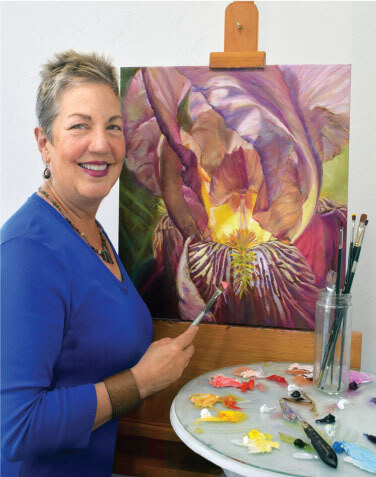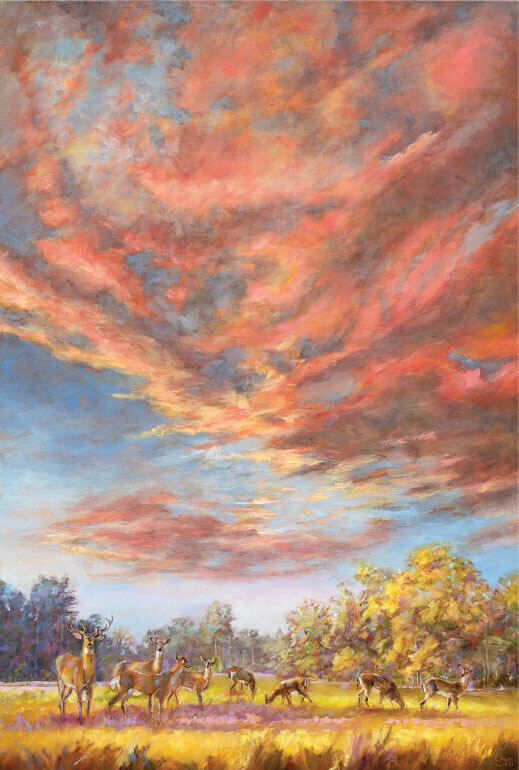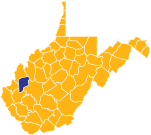Pat Cross on the art of coming home to West Virginia.

written by DONNA HERTO
Artist Pat Cross grew up in West Virginia, then left for three decades. When she returned in 2013, she settled in Eleanor—a small Putnam County town with a population of 1,500. Cross was awarded a grant from the National Endowment for the Arts and the West Virginia Commission on the Arts for a collection of 30 original paintings based on the benefits of living in the small town of Eleanor. The resulting works shows people interacting with the outdoors and the environment.
Titled Eleanor’s 2020 Vision, Cross’s collection was inspired by Eleanor Roosevelt, who designed the town of Eleanor in 1935 with healthy living in mind. The town’s appeal has evolved with the times, supporting a healthy well-being and lifestyle while providing meaningful community connections and safe, walkable access to the outdoors.
We caught up with Cross to ask her about coming home to West Virginia.

Where did you grow up in West Virginia, and where did you go when you left the state?
Pat Cross: I was born in McDowell County, where my father and grandfather worked in the coal mines. To pay for his engineering degree, Dad played the tenor saxophone in a jazz band until he accepted a job in Charleston. He then moved the family to Putnam County, and I soon found the art program at the vocational school in Eleanor, earning my degree in 1979.
I went to Middle Tennessee State University to further study the visual arts in the early 1980s. I had an insatiable curiosity about other natural geographies and traveled to the Tetons, the Rockies, the subtropics of Florida, and ultimately to the Cascades of the Pacific Northwest. There, I studied under oil painting masters and developed a flourishing business selling my art, often participating in regional and national juried exhibitions such as Realism New York, Bosque Art Classic, and Salon International. I relished the peak of my art career and my peer network of friends.
What brought you back to West Virginia?
PC: I recall an uncomfortable nudge, realizing that my parents would need my help sooner rather than later. I just could not ignore that persistent nudge to close the 3,000-mile gap between us. I liquidated my art business and sold my prized live-in art studio. In 2013, I moved back to West Virginia to be with my parents as my dad approached a serious surgery, spending the next several years intensively caring for my parents. My parents gave me the gift of life and were the first ones to cultivate my art talent.
When you returned, what did you find was the same as before you left?
PC: I remember my first morning back in West Virginia. I awoke to the cheerful chatter of birdsong. We didn’t have that very often out west. The sounds of West Virginia hadn’t changed—I was spellbound.
My parents’ love for the outdoors hadn’t changed, either. I grew up hiking, fishing, camping, and indulging in nature. I remember tagging along with Mom deep into the woods to discover what curiosities grew from the forest floor. Her passion for botanicals blossomed as a backyard garden that we would tour with our morning coffee. In our fishing excursions, Dad’s hands and words continued to reveal the water currents that pulled our fishing lures towards the trout hidden in the cool shadows of the stream.

What did you discover had changed about West Virginia?
PC: I was pleasantly surprised that West Virginia is chock full of artists! Before moving back, I fretted the inevitable isolation, since I do not recall any creative comrades growing up here. Once I moved back, I discovered new creatives at every turn.
How do you experience West Virginia differently, having left and returned?
PC: After years of hiking in granite mountains, around glacial lakes, and through volcanic lava tubes, I see our ancient Appalachians with fresh eyes. I also developed an appreciation for the bonds and ties of family loyalty and forgiveness that run deep here with partners and family. I underestimated this before I left.
I’ve come to realize that West Virginians don’t give a flip about their public image. At first, this was distressing to me, especially as I urged my art peers to market their work and met with indifference. Yet, it’s refreshing, if not endearing, that people here aren’t so caught up in their public image. West Virginians have a down-to-earth culture that focuses more on others than on themselves.
What would you say to someone who wonders if small-town life can be satisfying?
PC: Small-town life is far more satisfying than I anticipated, and I’ve lived in rather special places. I’m enchanted by the simplicity and safety and the slow pace allowing me to breathe, walk, see, hear, and experience more. Perhaps the slow pace helps people care about others—or is it the caring for others that encourages the slower-paced life?
What would you say to someone who is curious about West Virginia?

PC: We have elbow room to think and develop our own talents, to hear our own voices from the clamors of the crowd. These folds in the earth called the Appalachians form incubators that cultivate talent and types of genius. We have Chuck Yeager, Pearl S. Buck, and the Rocket Boys—people who have changed the world from their roots in West Virginia.
See Cross’s paintings celebrating life in Eleanor and her other works at patcrossart.com.
READ MORE ARTICLES FROM WV LIVING’S SPRING 2023 ISSUE









Leave a Reply